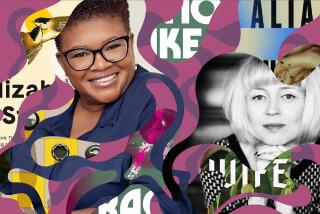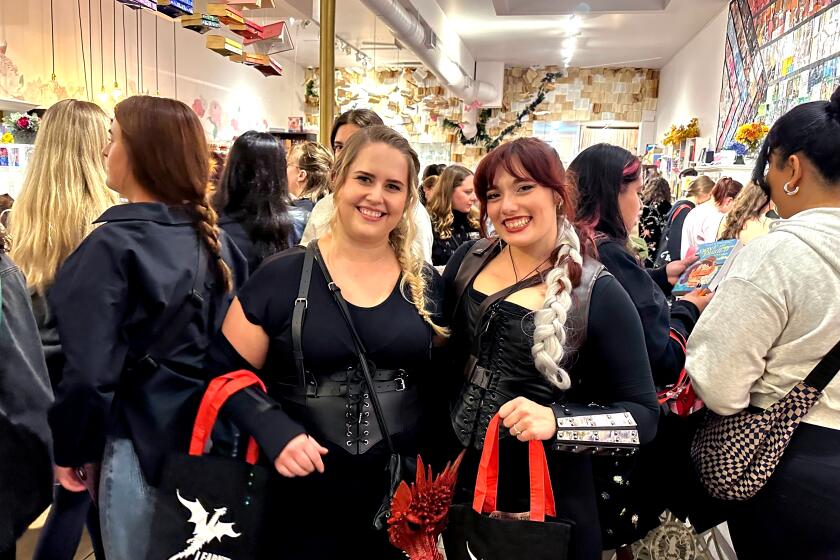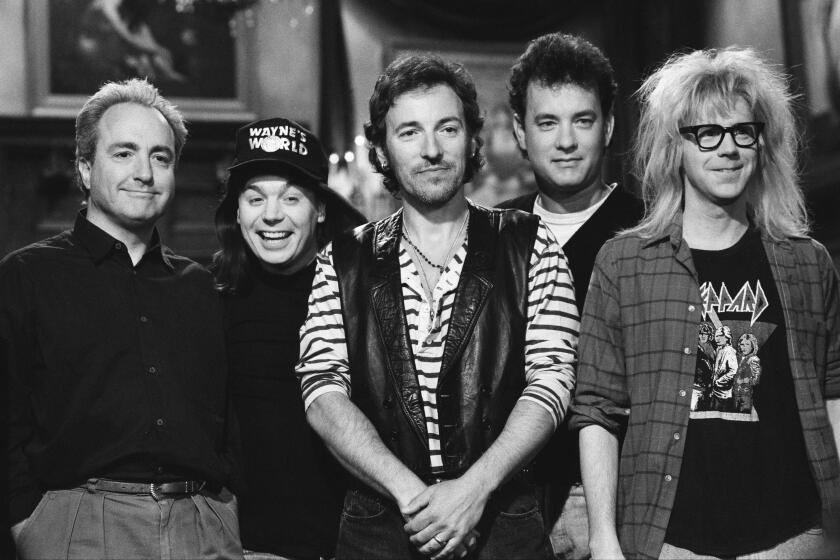The World at Her Feet : Best-Selling Author Barbara Taylor Bradford Lives the Glamorous Lifestyle of Her Characters
- Share via
Facing her well-stocked closet, Barbara Taylor Bradford is caught in a small, pleasurable dilemma: What to wear for the evening’s dinner party--the elegantly tailored dress designed by a Paris couturier, or the flirtatious red-skirted ensemble by her favorite New York designer?
The multimillion-dollar author is deliberating over this embarrassment of riches in the living room of her bungalow at the Beverly Hills Hotel.
On the occasion of her latest best seller, her publisher, Random House, has flown her here on a VIP publicity trip. Her husband, producer Robert Bradford, who has transformed all but one of her novels into television miniseries, has jetted out to be by her side. Her personal publicist is on hand. And a press packet has been prepared, extolling her books’ vital statistics: more than 30 million copies sold in English-language editions and publication in 34 countries.
A household word in England, the British author of romance novels is also building her name--and her fortune--in the United States, where she has lived for more than 26 years. In an industry dominated by deep-pocketed corporations, Bradford is a guaranteed money-maker with whom publishers are making record-setting mega-deals.
Her present book, “The Women in His Life,” jumped into the No. 1 slot on British best-seller lists mere days behind the novel’s June publication date. In a review of the book, the British newspaper the Evening Standard, noted, “While ‘The Women in His Life’ lacks the page-turning intensity of, for instance, ‘A Woman of Substance,’ the tightly knit plot is splendidly sustained.”
Appearing in bookstores last Thursday in the United States, the work is the first product of a $10-million three-book contract, engineered by literary agent Morton Janklow. Janklow, who represents such authors as Jackie Collins, Judith Krantz and Danielle Steele, named his take-it-or-leave-it price to the publishers--”no negotiations,” Bradford says. And that was for U.S. and Canadian rights only.
“The rest of the world is mine ,” Bradford says with a smile.
The author is sitting on the bungalow’s peach brocade couch (her favorite color) in a room fresh with flowers. At 57, Bradford is a handsome woman, coiffed and dressed with impeccable English order. Living the world-scale glamour her novels portray (“I write about places I know”), she unabashedly loves clothes, fine antiques, handsome men and expensive hotels.
Her style is chit-chatty (she has a small chipped tooth, a wonderful Romanian manicurist and plans to redecorate her kitchen and dining room next year) and alternately decisive, in the manner of Margaret Thatcher, whom she much admires. Her conversation is heavily referenced with the names of the rich and powerful: her friend Hannah Pakula, director Alan Pakula’s wife, who wrote about Elena Ceausescu in Vanity Fair; Queen Elizabeth’s cousin, Lord Lichfield, who took her portrait, bedecked in emeralds, for her new novel’s dust jacket; publishing magnate Rupert Murdoch and his wife, Anna; Spanish singer Julio Iglesias and, last but not least, the loyal steed of her world travels, the Concorde. (It bore her home from London two years ago when her fluffy white bichon frise, Gemmy, became temporarily paralyzed.)
She and and her husband have just returned from a vacation in St. Jean-Cap-Ferrat on France’s Cote d’Azur, which followed a three-week promotional tour through Britain. Relaxed, Bradford is again ready to talk about “The Women in His Life.”
The set piece of the room’s coffee table, the book shimmers in its red jacket, with the author’s name in “lapis royal blue purple,” as Bradford describes it. She set out to re-create the colors from the packaging and graphics of Giorgio Beverly Hills’ perfume Red, she says.
“ ‘I want it to be packaged like cosmetics,’ I told (Random House publisher) Joni Evans. ‘I want it to have that look that somebody wants to reach for it.’ Packaging is so important in selling perfume.”
But the principal reason that her books sell well is, as she states, “that I’m a brand name. When a book comes out, they grab it.”
The story now up for grabs is a departure from her panoramic sagas centered on strong-willed women, which began with her blockbuster, “A Woman of Substance,” published in 1979. In “The Women in His Life,” Bradford tells the tale of Maximilian West as his life sweeps by those of his mother, his nanny, and a trio of wives. A beautiful billionaire corporate raider, West is “power personified,” a man who dashes about a world staged with marble mansions, women ready for seduction and corporations ripe for takeover. In a “This Is Your Life” ending, West comes to his senses, pleading in a post-epiphanic cri de coeur, “No more champagne”; he takes brandy instead.
Nonetheless, the book’s subject matter accurately reflects the author’s interests. “I think finance is fascinating,” Bradford says. “That’s why I made ‘Maxim’ a tycoon. Business and money interest me. Not money in the sense of something to spend, but as a monetary unit, a tool of industry.”
Utilizing historical drama, the book’s action progresses from Kristallnacht, the first of the Nazi pogroms, on Nov. 9, 1938, to the dismantling of the Berlin Wall 51 years later. At its most informative, the novel recounts resistance to Hitler in Germany’s upper social ranks and West’s (shortened from Westheim) childhood escape from the country, which is loosely based on Bradford’s husband’s experiences as a German Jew fleeing Berlin.
A supporter of a strong Germany functioning within a European political framework, Bradford declares, “They’ve spent 45 years trying to expiate their crime. The Nazis only wanted power for the sake of having power; they didn’t want it for economics. Germany is going to be the most dominant country in Europe, but not necessarily warlike.”
With the major exception of a nurturing nanny (Bradford’s mother was a nanny before she married), the novel is less supportive of women, often depicting them as frivolous, (two New York working women are shown as egregious new-rich hustlers) and it assumes an ethical allegiance to the monied class.
“The book has no message,” Bradford says, adding: “It’s a book people can read quite easily. I work very hard to make it easy to read, without descending into an infantile prose style.”
As for literature in general, she says, “You tell me someone who’s writing literature today and I’ll go buy the book.”
Examples are given.
“But how many people read them?” she ask.
Bradford’s own desire to be a novelist began when she was a child growing up in Leeds, in the industrial north of England. The daughter of a machinery engineer, she says she was both spoiled and driven to make a success of herself. She sold her first short story at the age of 12 and later bypassed college to get on with a career as a journalist, working for a year as fashion editor of Woman’s Own, a popular women’s magazine, and interviewing celebrities for the large-circulation evening paper, the London Evening News.
After her marriage, she moved to New York in 1964, and for 12 years wrote a syndicated newspaper column on interior design. Following four attempts at writing suspense novels, she turned to the saga, finding immediate success with “A Woman of Substance.” In this best seller, Bradford’s heroine, Emma Harte, rises from poverty in a small Yorkshire town to become the head of an international merchandising empire and one of the world’s wealthiest women.
Bradford resents press correlations of her frequently termed “rags-to-Vuitton” rise with that of Emma Harte. She says she “loathes” a profile published recently in the Sunday Times, which mentions “childhood deprivation” and describes her father as a “wooden-legged” former soldier. “His leg was made of aluminum,” Bradford corrects, saying: “I come from an ordinary middle-class family.”
Like Harte, however, she admits she is a workhorse who starts at sunup and puts in 12-hour days in her office, which is decorated like a library, she says. Two walls of books contain such favorite novelists as Irwin Shaw and James Clavell, as well as Charles Dickens, the Bronte sisters and a biography of Winston Churchill. Her typing table is custom-made to blend with her Victorian desk; the walls are pale yellow, the carpet fir green, the sofa and ballon curtains done in flowered chintz, she says.
She will be returning to their New York apartment (“47th floor overlooking the East River”), while her husband is off to Hong Kong to begin filming a TV miniseries of “To Be the Best,” the last novel in the Harte trilogy. Before beginning her next book in the fall, Bradford plans to take the rest of the summer off.
There will be time for lunch dates with pals such as Fran Weissler (Broadway producer with her husband, Barry, of “Gypsy” and “Cat on a Hot Tin Roof,” she notes) at restaurants such Le Cirque, the Russian Tea Room, and, she says after a second’s consideration, “maybe some little place.”
More to Read
Sign up for our Book Club newsletter
Get the latest news, events and more from the Los Angeles Times Book Club, and help us get L.A. reading and talking.
You may occasionally receive promotional content from the Los Angeles Times.









